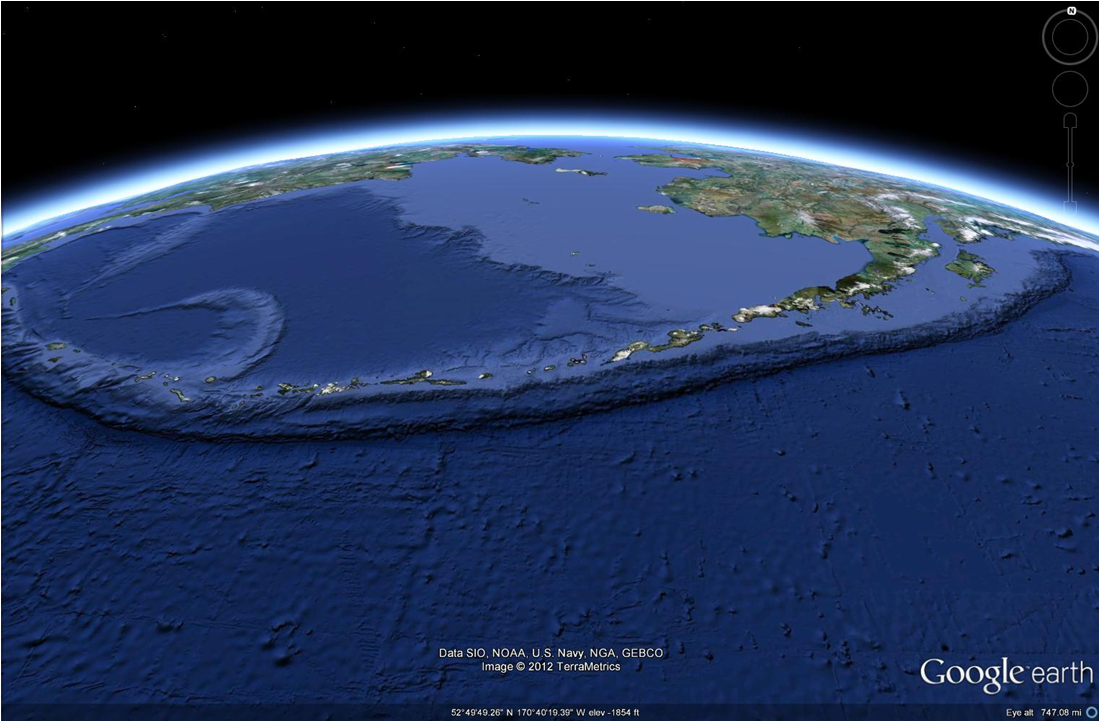Subduction Zone Dynamics in the Mantle and at the Earth's Surface
Subduction zone dynamics in the mantle and at Earth's surface
An educational module for the University of Maine School of Earth and Climate Sciences courses in Geophysics and Fluid Dynamics
Created by Sam Roy (Samuel.g.roy@maine.edu) on 4/28/2012 Last edited on 8/2015
Two main hypotheses to explore:
1. Mantle advection controls surface deformation through mechanical coupling of lithosphere and asthenosphere.
2. The lithosphere is non-Newtonian and exhibits strain weakening behavior, this can lead to strain localization and slab detachment. Strain rate is normally greatest in the subduction hinge therefore weakening and detachment would probably occur there.
1. Introduction:The surface of the Earth takes many varying shapes, from high craggy peaks and steep gorges to rolling hills and flat coastal plains. But how and why does the Earth's surface takes its form? There are many processes that play an active role in the creation of topography and landforms, but in this module we will explore the role of mantle advection as the primary mechanism behind surface deformation (Figure 1). First, I will discuss our physical understanding of mantle dynamics, then we will use a physical model to explore the sensitivity of surface shape to various rheological conditions in the lithosphere and underlying mantle.
2. Physics A thorough understanding of surface deformation requires a thorough study of the coupling between lithosphere and the underlying mantle. We will apply the Navier-Stokes equation to define fluid movement in the Earth. For our purposes, let’s approximate the rheological properties of the lithosphere and mantle as high viscosity, incompressible fluids with no elasticity. This means that we assume the elastic and plastic properties of the lithosphere are insignificant and volumetrically dominated by the viscous behavior below, at least for the large spatial scales and long timescales we are interested in. I will now go into more detail on the derivation of Navier-Stokes, the basic equation used to define fluid flow.
2.1. Navier-Stokes derivation How is the Earth like a fluid? Fluids are able to flow, or internally deform, when a force is applied on them. Below its frictional exterior, the Earth can readily be defined as a high viscosity fluid. This force can take the form of a loading stress, where the fluid experiences pressure due to the loading of more fluid above it
(1) P = ρ g h sin(α)
where ρ is density of the fluid, g is acceleration due to gravity, h is the height of the overlying fluid, and α is the angle of the fluid surface. If the fluid boundary is not horizontal, a pressure gradient exists until the fluid deforms to once again create a horizontal surface. This deformation is opposed by the dynamic viscosity of the fluid, defined mathematically as
(2) μ = σ / εij , εij = ∂vi / ∂ j
where μ is viscosity, σ is the stress initiated by gravitational acceleration, and εij is shear strain rate, or the change in i velocity in direction j. This equation holds true for Newtonian materials, which maintain a constant viscosity regardless of a change in strain rate. If we consider equation 1 as a component driving fluid flow, and equation 2 as a component resisting fluid flow, the two will equal each other if the fluid is in a kinematic steady state:
(3) ρ g h sin(α) = μ εij
We then take the partial derivative with respect to distance of both sides to establish that this relationship is true for a gradient ∇ in all considered dimensions
(4) ∇P = μ ∇ε , ∇ = ∂ / ∂i + ∂ / ∂j + ∂ / ∂k
Notice that I do not take the partial derivative of viscosity because it is considered to be a constant here. Now we can consider a volume force established by the presence of more than one fluid with different viscosities. A fluid that is more dense than a surrounding fluid wants to sink, and it will accelerate downward until there is great enough viscosity resistance to maintain a constant, terminal velocity. The complete Navier-Stokes formula is thus
(5) ∆ρ ∂v / ∂t = ∆ ρ g - ∇P + μ ∇ε
where ∆ρg is a volume force dependent on the density difference between two fluids, and ∆ρ ∂v / ∂t is the potential acceleration of the fluid body if resisting and driving forces do not equilibrate. This equation is simple, yet it defines the behavior of all non-turbulent fluid flow. In this present form we can use Navier-Stokes to consider the problem of fluid flow as gradients across a finite element continuum in two or three dimensions, discussed further below.
2.2. Temperature dependencies for density and viscosity The mantle and lithosphere are almost continuously coupled over Earth's entirety, therefore any differential movement in the mantle can produce deformation at the surface. Both mantle and crust can be considered as highly viscous fluids, and both fluid and density are temperature dependent. This is validated by the fact that brittle rock behavior normally occurs only within the first 15 km of crust, at which depth temperatures are conducive to dislocation creep of quartz, the most abundant upper crustal mineral. The Earth's density gradient between lithosphere and asthenosphere is established by the thermal gradient produced by radioactive decay of Uranium, Thorium, their daughter products, and mantle advection. Density is linked to temperature by the phenomenological volumetric expansion of heated material
(6) ρ = ρ0 - αv ∆T